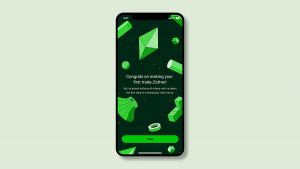Robinhood's Gamification of Investing
Founded in April 2013 by co-founders Vladimir Tenev and Baiju Bhatt, Robinhood Markets, Inc. is a financial technology company that operates an online brokerage for retail investors, offering commission-free trading through its web- and mobile-based platform. Robinhood allows users to buy and sell stocks, exchange-traded funds (ETFs), options, American depositary receipts (ADRs), and certain cryptocurrencies. As of 2022, Robinhood has over 15 million monthly active users and over 22 million funded accounts.
History
According to its founders, Robinhood was created to democratize investing and provide everyone access to the financial world. The name Robinhood comes from the company's mission to "provide everyone access to financial markets, not just the wealthy."[1]
Revenue Model
Payment for Order Flow
Payment for order flow is a system where instead of using a stock exchange to execute customers' trades, a broker will route trades to a market maker in exchange for a fee. [2] In this case, Robinhood will sell trades to a firm like Citadel, which will purchase the shares that the investor is selling and give Robinhood a fee for doing so, and Citadel will make a profit from re-selling the shares on the open market for a higher price. Robinhood earns less than one cent per share for routing these trades. Still, since users have executed over $150 billion in transactions, payment for order flow revenue adds up and now makes almost half of Robinhood's revenue. [3]
Robinhood's use of payment for order flow was at the center of regulatory scrutiny during the 2020 meme stock phenomenon, where GameStop and AMC, who seemed to have no intrinsic value, were trading for multiple times above their value weeks before, propelled by retail investors collaborating to dramatically raise the stock price. [4]
Subscriber Fees from Robinhood Gold
Robinhood offers a premium service named Robinhood Gold for $5 a month, which gives users access to more investing tools, including research reports, market data, larger instant deposits, and margin trading.
Income from Margin Trading
When Robinhood users engage in margin trading, they borrow from Robinhood Securities, which earns income from lending margin to counterparties. Users pay a 2.5% interest rate when they borrow over $1000 for margin trading.[5] The Company's addition of margin trading to its service faced controversy after the SEC said it was one of the ways they "provided misleading information to customers about the true cost of choosing to trade with the firm."[6]
Cash Management Fees
Robinhood receives fees on cash that is put into its Cash Management network from partner banks that extend FDIC insurance on deposits. Also, Robinhood receives interchange fees from customers using the Robinhood debit card [7]
Income from Cash
If customers have uninvested cash that isn't put into Robinhood's Cash Management network, The Company earns income by depositing it into interest-bearing bank accounts.[7]
Fees on Transfers and Other Services
Robinhood charges additional fees to customers for services such as transferring money to another broker, delivering checks overnight, and receiving paper statements.[7]
Gamification
Robinhood's Gamification of Investing
Gamification Case in Massachusetts
On December 16, 2020, Massachusetts securities regulators filed a complaint against Robinhood, alleging they "aggressively marketed to novice investors" and exposed them to "unnecessary trading risks" by "falling far short of the fiduciary standard that requires broker-dealers to act in their client's best interests." The filing by securities regulators focused on the tactics that Robinhood employs to keep customers engaged, alleging that it encourages them to use the platform through "gamification" features. [8]
User Interface
Robinhood's service was designed to give users a simple and easy-to-understand interface based on their mission to democratize investing by lowering the barrier to entry. [9] In the mobile app, users swipe up to confirm a stock transaction and perform similar microtransactions to obtain more information. Controversy has arisen because critics believe some features "promote strategies that benefit brokerages rather than consumers" [10]. For example, Robinhood users used to be rewarded with confetti showers (this feature was later removed after backlash [11]) when they bought their first stock to celebrate their first investment. Also, users receive one free stock in return for a referral to a new user. They see the awarded stock by scratching off an on-screen lottery card. Another feature Robinhood has implemented is an on-screen emphasis on trending stocks, highlighting rising share prices as an incentive to buy and falling share prices as an incentive to sell. Additionally, computer scientists have noted that Robinhood's interface mimics dark patterns or designed choices that steer users toward desired outcomes. [12] In Contrast to Robinhood's easy one-swipe purchase process, canceling a trade requires more friction and can steer users towards a desired outcome. [12]
Payment for Order Flow
Some critics say that the introduction of friction in trade cancellation and incentives to trade through certain gamification in Robinhood's interface may be linked to the fact that Robinhood's main revenue source comes from payment for order flow, where Robinhood receives more money when more trades are made. [12]- ↑ Robinhood.com, Our Story, https://robinhood.com/us/en/support/articles/our-story/.
- ↑ Massa, Annie, Payment for Order Flow, Bloomberg, March 19, 2017, https://www.bloomberg.com/quicktake/payment-for-order-flow.
- ↑ Foxman, Simone, Verhage, Julie, Woolley, Suzanne Bloomberg, October 15, 2018, https://www.bloomberg.com/news/articles/2018-10-15/robinhood-gets-almost-half-its-revenue-in-controversial-bargain-with-high-speed-traders
- ↑ Langley, Karen, AMC Leads Meme Stocks on a Wild Ride, Wall Street Journal, June 4, 2021, https://www.wsj.com/articles/amc-shares-slide-premarket-as-meme-stocks-stay-in-focus-11622796997
- ↑ Thune, Kent Seeking Alpha March 30, 2022 https://seekingalpha.com/article/4447377-how-does-robinhood-make-money
- ↑ US Security and Exchange Commission SEC.gov December 17, 2020, https://www.sec.gov/news/press-release/2020-321
- ↑ 7.0 7.1 7.2 Robinhood, Robinhood.com, https://robinhood.com/us/en/support/articles/how-robinhood-makes-money/
- ↑ Massa, Annie, McDonald, Michael, Alexander, Sophie, Bloomberg, December 16, 2020, https://www.bloomberg.com/news/articles/2020-12-16/robinhood-accused-of-gamification-by-massachusetts-regulator
- ↑ Zhong, Jeffrey, Medium, September 10, 2019, https://medium.com/@jeffrey_zhong_35871/robinhoods-simple-user-interface-76a2ee7cd6e
- ↑ Gallo, Nick, Finmasters, June 29, 2022, https://finmasters.com/gamification-of-investing/#gref
- ↑ McCabe, Caitlin, Wall Street Journal, March 31, 2021, https://www.wsj.com/articles/robinhood-to-remove-controversial-digital-confetti-from-trading-app-11617195612
- ↑ 12.0 12.1 12.2 Tan, Gordon, Democratizing finance with Robinhood: Financial infrastructure, interface design and platform capitalism, September 13, 2021

